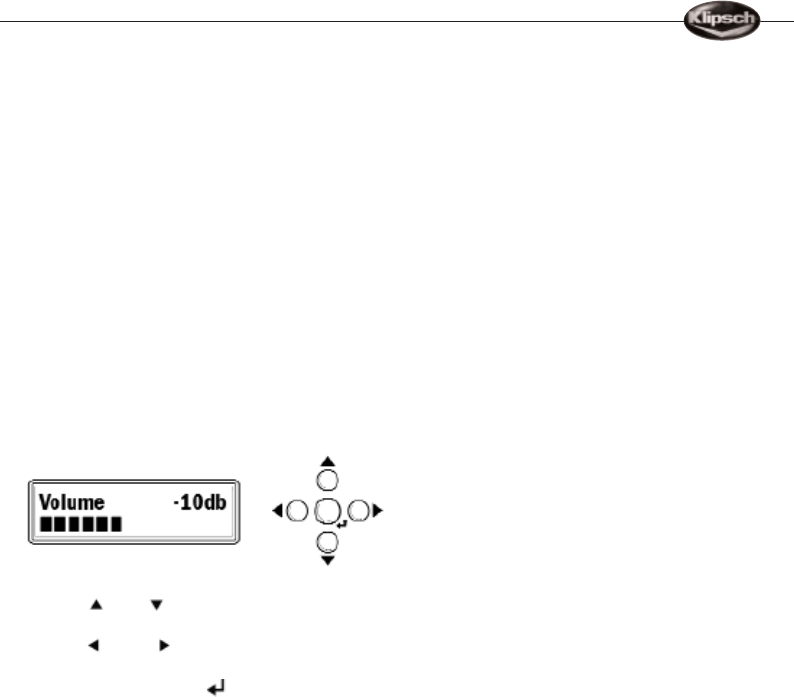
RW-10d / RW-12d
“HIGH LEVEL IN”
- These connections can be used as an
alternate connection method to the line level hook up. Using
16- gauge or larger speaker wire, connect the Red “positive” (+)
terminal of your amplifier’s Left channel to the Red “positive” (+)
terminal of your subwoofer’s Left channel ”HIGH LEVEL IN”
terminal. Connect the Black “negative” (-) terminal of your ampli-
fier’s Left channel to the Black “negative” (-) of your subwoofer’s
Left channel ”HIGH LEVEL IN” terminal. Repeat this procedure for
the Right channel connections (refer to Figure 4). Take care that
no bare wires from any of the connections can touch any of the
other terminals as damage to your equipment could result.
CONTROLS
All of the subwoofer’s controls, and changes to control settings,
are accessed through the cursor key pad and display on the top
of the subwoofer’s cabinet.The only exception to this is the main
AC power switch which is located on the rear panel of the
subwoofer.
• Use the (UP) or (Down) key to scroll through the list of
control options.
• Use the (Left) or (Right) Key to make adjustments to a
given control setting
• Use (IE Center Key) when the “ ” appears on the display
to store and recall custom settings or to lock the keypad
• After adjusting the individual control parameters for “Volume”,
“EQ Mode”, “Low-pass filter” and “Phase”, your settings can
be stored in one of three user memories (“Movie”, “Music”
and “Night”). This allows for global recall of all of the above
settings to tailor the subwoofer’s performance to compensate
for differing source material and uses.
• The display will return to the “Volume” screen after 10
seconds if no adjustments are made while in any other control
or display mode.
• In periods of low humidity, it is possible that a static electricity
discharge to the subwoofer may cause a momentary
interruption in the subwoofers output or changes to the LCD
display content. Any display content errors will be corrected
when the screen changes modes.
“Volume” - Use the Left/Right cursor keys to adjust the
subwoofer’s volume level to match the output of your main
speakers. The volume control on your system’s main amplifier
or pre-amplifier will be the overall volume control for your
subwoofer and full range speakers. Press and hold (or press and
release) the Left cursor key to decrease the subwoofer’s volume.
Press and hold (or press and release) the Right cursor key to
increase the subwoofer’s volume to the desired level. From
this screen press the down cursor key to access other control
settings.
“Recall Settings:” - This screen is used to select any one of
three, user defined, memory presets titled “Movie”,“Music” and
“Night”. Use the Left/Right cursor keys to select the desired
group of stored control settings and press the Center key to
apply them. “Settings Recalled!” will then be displayed.All of the
user settings, in the three memory presets, can be erased and
restored to their default values by scrolling down to the last
“System Info” screen. Press the Right cursor key twice to get to
the “System Reset” screen. Press the center cursor key and all
user settings will be replaced with the default settings. “Reset
Complete” will be displayed. During initial setup, skip this screen
until all other initial control adjustments have been made. From
this screen press the down or up cursor key to access other
control settings.
“EQ Mode:” - This screen is used to select two different Bass
emphasis settings, titled “Punch” and “Depth”. They are designed
to complement different types of program material, such as
movie soundtracks or music. The “Punch” setting emphasizes the
60Hz region while the “Depth” setting boosts the 30Hz range.A
third setting is titled “Flat” which defeats these two settings. Use
of either of these EQ settings will slightly reduce the subwoofer’s
maximum output capability as they will require more of the
subwoofer’s amplifier power.Use the Left/Right cursor keys to
select the desired EQ setting. From this screen press the down
or up cursor key to access other control settings.
“Lowpass” - This screen is used to adjust the subwoofer’s
upper frequency limit to achieve a proper blend with your
system’s main speakers.A higher frequency (Hz) is typically used
with smaller, bass limited main speakers and a lower frequency
setting is customarily used with larger floorstanding models. This
filter can be adjusted from 40Hz to 120Hz, as required, or
defeated if the low pass filter function is being performed by your
system’s electronics. Use the Left/Right cursor keys to adjust the
lowpass filter.To defeat this filter press and hold the Right cursor
key until “Lowpass OFF LFE Mode” is displayed. Refer to your
surround processor’s owner’s manual for more Bass
Management information. From this screen press the down
or up cursor key to access other control settings.
“Phase” - This screen is used to adjust the subwoofer’s acoustic
phase to match that of your main speakers. Use the Left/Right
cursor keys to adjust the subwoofer’s phase from 0° to 180°.
The proper setting of this control is highly dependant on room
acoustics and the position of your subwoofer in the room. After
setting the volume and lowpass controls set the phase to 0˚ and
listen to a recording with a prominent, repeating bass line in your
intended listening position. Repeat this process with the 180°
setting and use the setting that yields the greatest amount of
bass output. If neither of these settings is better than the other


















